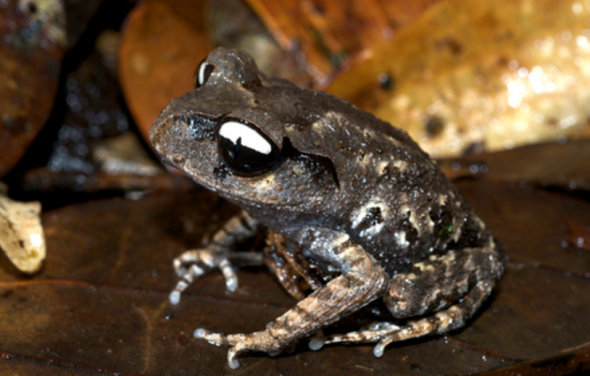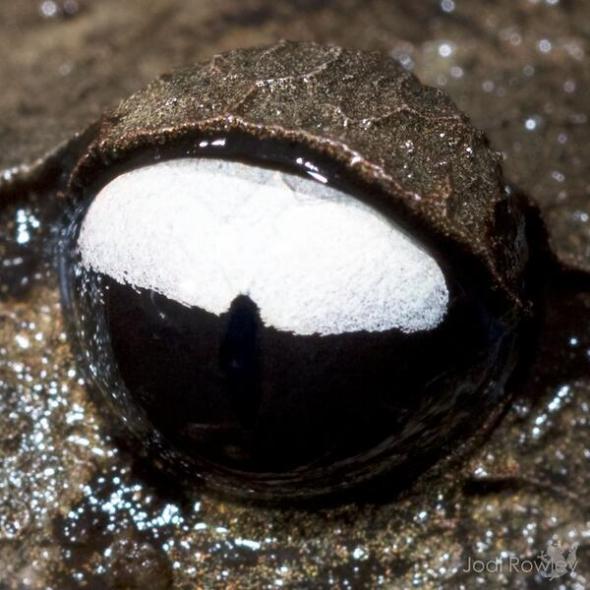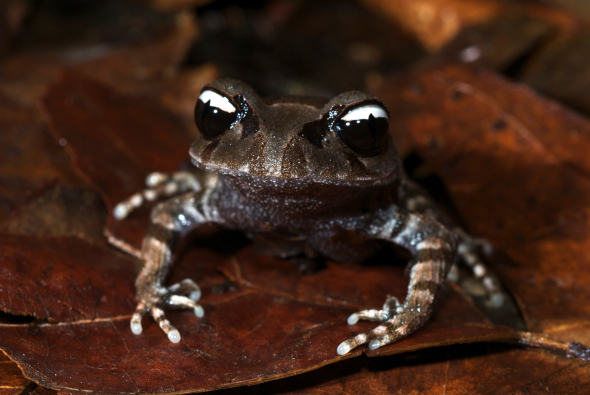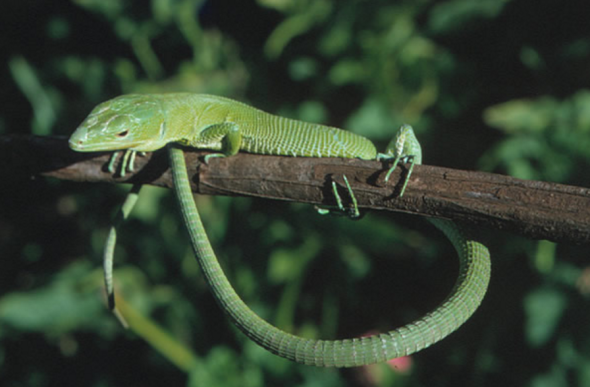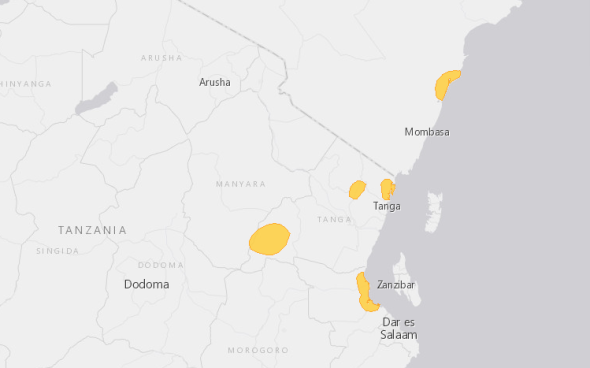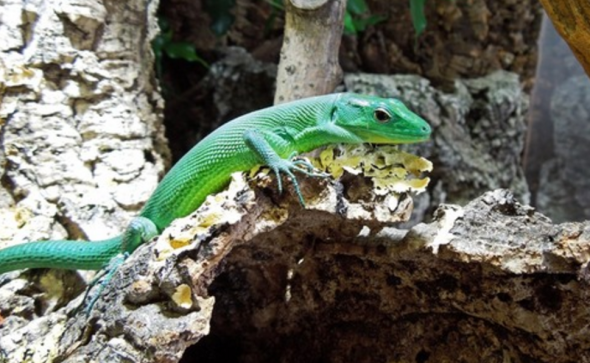Endangered Species Monday: Leptobrachium leucops | Yin and Yang
Endangered Species Monday: Leptobrachium leucops
This Monday’s (E.S.P) Endangered Species watch Post I document on this utterly stunning species of Asiatic toad, which some people believe is possibly a frog. Before reading any further, please check out this toads amazing eyes, stunning don’t you think? The species was “allegedly identified back in 2011” by an environmentalist identified only as Dr Stuart Rowley. Welcome to the Yin and Yang Frog.
Evidence tracking shows that a “Dr John Stuart Rowley, 1907-1968 whom I believe was an ornithologist from the United States, may have been the primary ‘herpetologist that located and documented on the species above’, however I believe that I am still slightly wrong on this and that Dr Jodi Rowley can shed more information on this amazing reptilian. Image credit: Mme Dr Jodi Rowley.
Listed as vulnerable due to the species living within a small habitat estimated to be 7,617 km2, the L. leucops is endemic to Viet Nam, South East Asia, furthermore there are no records that prove the species is used within the Asiatic medicine trade known as (TCM), Traditional Chinese Medicine. Populations are now known to be decreasing primarily due to the illegal and unregulated trade of timber, which is growing rapidly out of control within Viet Nam, Thailand and China.
Leptobrachium leucops is now known to be residing within only ten locations in Viet Nam, and to be honest there is little known about this elusive reptilian other than a handful of threats, and its identified habitat which is somewhat frustrating as the species is rapidly dwindling into I believe extinction. Experts “rediscovered this rather unusual toad within the Bidoup Núi Bà National Park, Viet Nam, South East Asia back in 2011, the scientists were from America, Australia and Viet Nam.”
The common name for this species as you may already have noticed by its utterly peculiar eyes is - The Yin and Yang Toad, although some reports have suggested that the “Yin and Yang Toad” is possibly a “Yin and Yang Frog”. Please view the image below.
Image Credit. Dr Jodi Rowley, Yin and Yang Toad/Frog?
The DINews.com, Viet Nam stated “When it comes to frogs in the genus Leptobrachium, the eyes have it. Among its more than 20 species, there is a remarkable variety of eye colouration. Leptobrachium leucops or Yin and Yang frog, discovered in 2011 in the wet evergreen and cloud forest in southern Vietnam, is distinguished by its striking black and white eyes”…
NB: There doesn’t seem to be any scientific reference that suggests this species is a toad or frog. The SSC Amphibian Specialist Group merely states “species” rather than “frog or toad”.
The Yin and Yang reptilian resides at high altitudes in montane tropical forest of which the reptilians diet compromises mainly grubs, flies, worms and grasshoppers. Leptobrachium leucops is like most frogs and toads carnivorous and will occasionally also consume small amounts of meat. The species is not known to a be a migrant either.
As explained above populations are known to be on the decline, however until further research is undertaken its unsure as to what extent declines are. The SSC Amphibian and Reptilian Group was quoted “Further research is required to determine this species’ actual range and abundance, but due to ongoing habitat loss and fragmentation, its population is suspected to be decreasing”…
Image Credit: Dr Jodi Rowley / Panda.org
MAJOR THREATS
The harvest of timber and non-timber forest products are likely to result in some habitat loss and modification, which is a potential threat to the species. The construction of a road through Bidoup-Nui Ba National Park may serve as a barrier to dispersal and is likely to increase habitat disturbance.
It’s unsure what the future holds for this rather unusual reptilian due to limited research since 2011. The species as we know it is listed as vulnerable, and should further research show a continued increase in relation to logging and habitat disturbances, its likely the species may be re-listed as (endangered). We can only hope that the team of American, Australian and Vietnamese scientists that allegedly discovered the species back in 2011 - can shed more light on this rather unusual reptilian.
This is the shortest and limited (detailed) article I do believe I have ever written regarding anyone of the animals within the I.A.R.F. Endangered Species watch Post articles printed every Monday and Friday. One does have to take their hat off though this truly spectacular species of reptile, those eyes are just utterly amazing, and is this where the “Yin and Yang Asiatic designs” originated from? Have a great Monday..
Thank you for reading.
Chief Environmental Officer and Executive Officer.
International Animal Rescue Foundation.
Dr Jose C. Depre PhD. MEnvSc. BSc(Hons) Botany, PhD(NeuroSci) D.V.M.
Environmental & Human Science
To subscribe to to our ‘free news letter service’ please click either of the links below.
Pet, Bush and Wildlife Trade (Enter your name and email and we’ll keep you updated free of charge about our active work online and on the ground)
Environmental News and Investigations (Click the right hand-side subscribe link and you’ll be emailed freely)
Please note: International Animal Rescue Foundation and the Anti Pet and Bush Meat Coalition are 90% self funded. However at times we do require donations from the public to continue running ground operations. When you donate you like we will be sent an “electronic receipt”. Every single member of the public that donates are also communicated too when their donations are used, and what on. To donate please click >here< and follow the Facebook donate instructions. International Animal Rescue Foundation every year provides many monetary grants to organisations that we believe can benefit, that’s the whole purpose of this organisation - to help all and not just some.
Thank you.
Rate this:
January 25, 2016 | Categories: You must be the change you want to see in the world | Tags: Asian Frogs, Asian Reptiles, Bidoup Núi Bà National Park, deforestation, Dr Jodi Rowley, Dr Jose Depre, Dr Stuart Rowley, Frogs, habitat fragmentation, International Animal Rescue Foundation Asia, Leptobrachium leucops, Logging, Monday's animal, Private Life of Mother Nature Facebook., SSC Amphibian Specialist Group, TCM, Timber, toads, traditional chinese medicine, viet nam, Vietnamese frogs, Vietnamese toads, Yin and Yang | Leave a comment
Endangered Species Friday: Gastropholis prasina.
Endangered Species Friday: Gastropholis prasina
In this Fridays Endangered Species Watch Post (ESP), I focus briefly on this rather elusive species of Green Keel bellied Lizard, that’s endemic to the continent of Africa. I’ve long adored our African reptilians, unfortunately they’re own habitat like many larger species of fauna is under threat… (Image credited: S. Spawls) Green Keel bellied Lizard.
Listed as (near threatened) the species was primarily identified by Dr Franz Werner (15 August 1867 in Vienna - 28 February 1939 in Vienna) was an Austrian zoologist and explorer. Specializing as a herpetologist and entomologist, Werner described numerous species and other taxa of frogs, snakes, insects, and other organisms.
I thank Dr Werner (despite not being alive today), for his truly amazing journeys all over the African continent of which he located many hundreds of different reptiles, snakes, frogs, worms, and an assortment of other mammals. Had Dr Werner not followed on from his fathers footsteps its quite likely the Green Keel bellied Lizard wouldn’t be known today (among many other animals this amazing man identified).
Gastropholis prasina was originally identified back in 1904, then re-classified by Dr Loverbridge back in 1936 as (Bedriagaia moreaui ). However today this is not the species true name, G. prasina remains the true identity. Endemic to Kenya and Tanzania, the species is commonly known found along the eastern arc of Kenya and Tanzania’s coastal plain.
Localities are: Watamu, Arabuko-Sokoke Forest, Amani in the Usambara Mountains, Tanga, Zaraninge Forest, and the Nguru Mountains. The reptilian probably also occurs in Kenya’s Shimba Hills, however this has yet to be fully confirmed.
Populations are known to be “severely fragmented”, which has led to concerns that the species may soon be re-listed as (vulnerable or even endangered). Current historical data records show no evidence of a mean population count sparking more concerns that the species may be more “threatened than has been led to believe”. For now we can only assume (but not estimate) what the population count may be based on location and trapping (see image below). (updates to follow). Please view the map below of which details where the highest abundance of Green Keel bellied Lizard habitats remain today.
Image: Identified habitat locations of the Green Keel bellied Lizard.
Past records state the species is either “rare or considered very rare”, however I must point out that this historical data is from 1989 and a further assessment dated 2002. Vast swathes of habitat has been lost since the 1980’s and early millennium, habitat destruction is rife within Kenya and Tanzania, poaching, bush meat trade and land conversions are also increasing annually.. So in all honesty, none knows for sure if the species is now (to date rare or very rare), as records are out of date, which is an observational fact!
Unfortunately the species is neither listed on (Cites appendix I or II) despite the fact the reptilian is near (vulnerable). There remains no evidence that the Green Keel bellied Lizard is used within trade, or the Traditional African Medicine Trade (TAM). However there is evidence that the reptilian is collected during large scale tree felling for displays in local snake farms. Its quite possible the species “may be collected to feed snakes too” which if true could be seriously detrimental to the wild populations that are still unknown.
Image credit: Torsten Kunsch
Green Keel bellied Lizard is diurnal (either comes out during the day or not). The reptilian is also known to be quite secretive and arboreal (living mostly in or among trees), which could explain why the reptilian is at the best of times difficult to locate and study, especially if the animal wants to come out only at night. Environmental scientists are in a sense playing cat and mouse when it comes to studying that is.
Despite the species living primarily among trees, there is no evidence that the animal lives high up among the canopies either, (confusing I know). Specimens have been located mainly close to the ground or next to the base of trees, as seen within the images above (1-2). Further studies have shown that the reptilian can live as high as 12 meters from base level within the tree, but not exactly the canopy.
Investigations haven’t really shed much light as to whether the species is indeed affected by habitat disturbance. However where cashew nut farms are being grown within the animals habitat of which these farms have turfed up the animals natural homes, there does appear to be some evidence that proves the Green Keel bellied lizard cannot tolerate this type of habitat disturbance, so we’ll need to be looking into this more closely, followed up with surveys in relation to intensive logging and species collection.
While the Green Keel bellied Lizard is not listed on either of the appendixes, the reptilian is known to inhabited ‘protected parks’ being that of Arabuko-Sokoke Forest and the Amani and Zaraninge Forest.
Major Threats
Coastal forest is rapidly disappearing within this species’ range, and is thought likely to represent a threat to the lizard. While it has been recorded from cashew plantations, it is thought to require continuous tree cover. Expanding human populations along the fertile East African coast, and associated agricultural development, are the major threats to forest in this region (2014). Much of the species’ coastal distribution is, however, within well-protected areas, and its largest distribution centre is inland in the Nguru Mountains.
It’s uncertain what the future holds for this rather secretive lizard, furthermore its evident that threats while minimal are still present and increasing, we still don’t know what the actual true population count is neither. More studies need to be conducted to determine the exact population, and where required the necessary protection plans and (listing on either Appendix I or II) applied.
Video: Green Keel bellied Lizard in Captivity
Thank you for reading and please follow me on Twitter for more great news updates by clicking the link below… Have a Great Weekend.
https://twitter.com/josedepre11 < Follow me on Twitter here.
Did you know you can also follow us on Facebook here:
https://www.facebook.com/InternationalAnimalRescueFoundationAfrica/
Dr Jose C. Depre PhD. MEnvSc. BSc(Hons) Botany, PhD(NeuroSci) D.V.M.
Environmental, Botanical & Human Science
NB: Don’t forget that every Monday, Wednesday and Friday’s editions of environmental news, vegan and vegetarian recipes, endangered species Monday and Friday, and much more. You can subscribe for free via entering your email address into the “follow me” drop box on the right hand side of this page. Its free, and you’ll be emailed direct all new media around the world every week directly from the International Animal Rescue Foundation’s Environmental News and Media Team and myself.
Rate this:
January 22, 2016 | Categories: You must be the change you want to see in the world | Tags: (ESP) International Animal Rescue Foundation Africa, Africa, Amani, Arabuko-Sokoke Forest, Cashew Farming, Cites, Dr Franz Werner, Dr Jose Depre, Endangered Species Watch Post, Fridays Animal, Frogs, Gastropholis prasina, Green Keel bellied Lizard, Insects, IUCN, Kenya, Lizard, Near threatened, Nguru Mountains, Organisms, Reptiles, Reptilians, S.Spawls, Snakes, Tanga, Tanzania, Torsten Kunsch, Usambara Mountains, Watamu, Zaraninge Forest | Leave a comment

